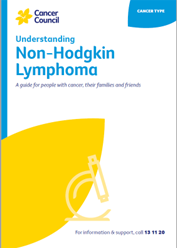Non-Hodgkin lymphoma
If you’re affected by non-Hodgkin lymphoma, you may have many questions about how it is diagnosed, treatment options, side effects and how to stay well. You can find trustworthy information about all aspects of your experience below.

Print these questions
Diagnosis
- What type of non-Hodgkin lymphoma do I have?
- What stage is my lymphoma? How far has the cancer spread? How fast is it growing?
Treatment
- What treatment do you recommend and why?
- Are there other treatment choices for me? If not, why not?
- If I don’t have the treatment, what should I expect?
- I’m thinking of getting a second opinion. Can you recommend anyone?
- How long will treatment take? Will I have to stay in hospital?
- Are there any out-of-pocket expenses not covered by Medicare or my private health cover? Can the costs be reduced if I can’t afford it?
- How will I know the treatment is working?
- Will the treatment cause any pain? How will it be managed?
- Are there any clinical trials or research studies I could join?
Side effects
- What are the risks and possible side effects of each treatment?
- Will the treatment affect my sex life or fertility?
- Are the latest tests and treatments for non-Hodgkin lymphoma available in this hospital?
- Should I change my diet or physical activity during or after treatment?
- Are there any complementary therapies that might help me?
After treatment
- Who should I go to for my follow-up appointments?
- How often will I need check-ups after treatment?
- If the non-Hodgkin lymphoma returns, how will I know? What treatments could I have?
Non-Hodgkin lymphoma is one of the two main groups of lymphoma. The other group is Hodgkin lymphoma.
Need to talk?
Dr Puja Bhattacharyya, Haematology Staff Specialist, Western Sydney Local Health District, Blacktown Hospital; A/Prof Christina Brown, Haematologist, Royal Prince Alfred Hospital and The University of Sydney; Dr Susan Carroll, Senior Staff Specialist, Radiation Oncology, Royal North Shore Hospital and The University of Sydney; Jo Cryer, Clinical Nurse Consultant, Haematology, St George Hospital; Marie Marr, Consumer; Katelin Mayer, Clinical Nurse Consultant, Cancer Outreach Team, Nelune Comprehensive Cancer Centre, Sydney; Vanessa Saunders, 13 11 20 Consultant, Cancer Council NSW; Elise Toyer, Haematology Clinical Nurse Consultant, Blacktown Hospital.
View the Cancer Council NSW editorial policy.